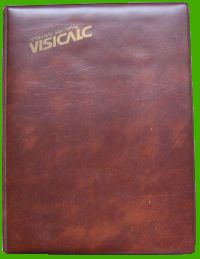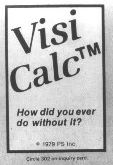VisiCalc 1979
After long debates about whether our newly merged company should be in Boston or Toronto, we had decided that it should be where the action was, in Silicon Valley. On the first weekend in January, 1979, Dan and I attended the Consumer Electronic Show in Las Vegas. After the show, Dan returned to Boston to attend classes at Harvard and manage the rapidly growing business still being run out of his Allston apartment. I headed up to Sunnyvale to find office space and make initial contacts with bankers, suppliers, and industry people. During my meeting with Regis McKenna, who we were trying to convince to become our ad agency and public relations firm, Dan called to tell me that Microchess sales to date had now exceeded one million dollars.
 It was on this trip that I met with Mike Markkula, then Chairman of Apple Computer. One of the reasons for
meeting was to demonstrate a very early version of VisiCalc. I loaded it onto his computer and created
the standard P&L demo in a matter of seconds. At this time there were no file commands, so I couldn't have
loaded a canned spreadsheet if I had wanted to. Mike watched the demonstration without great enthusiasm.
Then, he picked a diskette off his desk and loaded “something really interesting”. He had been writing a checkbook
program in Apple Basic. I tried to explain that VisiCalc could be a checkbook program as easily as it was
a budgeting program, but he didn't really get it. He was too excited by his first program.
It was on this trip that I met with Mike Markkula, then Chairman of Apple Computer. One of the reasons for
meeting was to demonstrate a very early version of VisiCalc. I loaded it onto his computer and created
the standard P&L demo in a matter of seconds. At this time there were no file commands, so I couldn't have
loaded a canned spreadsheet if I had wanted to. Mike watched the demonstration without great enthusiasm.
Then, he picked a diskette off his desk and loaded “something really interesting”. He had been writing a checkbook
program in Apple Basic. I tried to explain that VisiCalc could be a checkbook program as easily as it was
a budgeting program, but he didn't really get it. He was too excited by his first program.
In 1979 I demonstrated VisiCalc to hundreds of people who had never seen a spreadsheet before. The range of responses was very interesting. In general, programmers and people who understood how difficult it is to make computers do things reacted with awe and instant respect. On the other hand, non-computer-literate people tended to be nonchalant. They just thought that computers could do that sort of thing and it was no surprise to them at all. They probably also thought you could just type a request for information about any topic into the computer and it would provide you with an answer, too. They would not have been the least surprised to see Google demonstrated.
The earliest test versions of VisiCalc all lacked a file system. It was understood that for optimal performance and to ensure maximum available memory it would be better to access the disk drive directly than to use any part of Apple DOS. Fortunately, I had recently disassembled the Apple disk operating system in order to create efficient file handling routines for Micro-ADE. I was able to provide Bob Frankston with source listings of fully working low level routines that he could incorporate into VisiCalc. That was my minor contribution to the VisiCalc source code. Later this same expertise would come into play as we developed a copy protection mechanism for the first release.
 By April, VisiCalc was fairly advanced and reliable. Although it could not yet print, the calculation
functions were stable and it could be used for real calculations. Faced with many decisions about my
tax return for 1978, I created the world's first spreadsheet to do a tax return and applied the famous what-if
queries to the data. Although there was no print facility, I was able to use some of my own debug programs
to save the screens to the printer for delivery to my accountant. [Note: I have just learned that
Bob Frankston also used VisiCalc to do his 1978 tax return. In the process, he discovered he needed
a lookup table for the tax rates, and incorporated the @lookup command then and there. One of the reasons
VisiCalc was so complete and elegant in its first release is that we were all using the program for so
long during the development phase.]
By April, VisiCalc was fairly advanced and reliable. Although it could not yet print, the calculation
functions were stable and it could be used for real calculations. Faced with many decisions about my
tax return for 1978, I created the world's first spreadsheet to do a tax return and applied the famous what-if
queries to the data. Although there was no print facility, I was able to use some of my own debug programs
to save the screens to the printer for delivery to my accountant. [Note: I have just learned that
Bob Frankston also used VisiCalc to do his 1978 tax return. In the process, he discovered he needed
a lookup table for the tax rates, and incorporated the @lookup command then and there. One of the reasons
VisiCalc was so complete and elegant in its first release is that we were all using the program for so
long during the development phase.]
